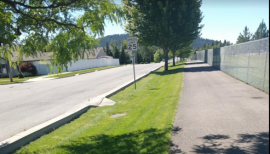Dry Swales

Brief Description
A dry swale is a shallow, gently sloping drainage channel with broad, vegetated, side slopes. Swales provide temporary storage, filtration, and infiltration of stormwater runoff. A dry swale is versatile because the area it requires is relatively small. They can be used in place of curbs, gutters, and storm drainage systems. Reduced channel velocities increase infiltration and water quality treatment. It effectively reduces and retards peak runoff. Channel vegetation can include turf, meadow grass, shrubs and – in limited quantities – small trees. They are always located above the water table to provide drainage.
Cost Range
Construction: $
O&M: $
Ideal Conditions for Installation
Precipitation: All
Soils: Permeable
Groundwater: Deep
Where/Applicability
Residential: Yes
Commercial: Yes
Ultra Urban: Yes
Industrial: Yes
Highway/Road: Yes
Retrofit: Yes
Maintenance
Frequency: Yearly
Type: Mow, Trim, Sediment removal
Monitoring: No
Permit Renewal: No
Performance
Total Suspended Solids (TSS): High
Chloride: Low
Total Nitrogen: Medium
Metals: Medium
Oils and Grease: High
Pathogens: Low
- Disclaimers: The approximate removal efficiencies above are based on research and may differ from one location to another. TSS removal is a function of the particle size. Refer to manufacture for details.
Specifications
Pretreatment is recommended to remove sediments and floatables.
1. Install all temporary erosion control measures prior to the start of any construction operation that may cause any sedimentation or siltation at the site.
2. Install storm drain inlet protection to prevent clogging of the storm sewer and sediment loads to downstream storm water facilities or waterbodies.
4. Grading of the swale shall be accomplished using low-impact earth-moving equipment to prevent compaction of the underlying soils. Small tracked dozers and bobcats with runner tracks are recommended.
5. Excavate the swale to the specified depth (elevation). It is recommended that all sub material below the specified elevation shall be left undisturbed, unless otherwise directed by the engineer.
6. Grade to the depth (elevation) specified in the construction documents unless otherwise directed by the engineer.
7. In the event that sediment is introduced into the bmp during or immediately following excavation, this material will need to be removed from the swale prior to initiating the next step in the construction process. This is especially important if the swale has been designed to infiltrate storm water: sediment that has been washed into the swale during the excavation process can seal the permeable material, significantly reducing the infiltration capacity of the soils.
8. Material excavated from the swale(s) shall be disposed of on-site at locations (stockpile areas) designated by engineer.
9. Non-standard component: clean, washed 1.5 to 3.5-inch gravel shall be placed in the bottom of the swale to the depth specified in the construction documents. Gravel should be placed in lifts and lightly compacted with plate compactors.
10. Non-standard component: the perforated pipe (underdrain) shall be laid directly on the gravel bed. Grade and alignment shall not vary from the prescribed grade by more than 0.03 feet at any point. The joints between sections of pipe shall be connected in a fashion acceptable to engineer. Once the pipe is in place, it shall be covered immediately with granular material as specified in the construction documents. The granular material shall be of uniform depth on both sides of the pipe. Special inlets and special devices at the outlet end of the pipe shall be constructed as shown in the plans.
12. Portions of swale to be planted shall receive 3" of woodchip mulch.
13. Portions of swale to be seeded shall be mulched with clean grain straw ) at a rate of 2 tons per acre.
14. Seeding and installation of erosion control blanket shall be completed within 48 hours of final grading.
Construction Sequence
1. Perform continuous inspections of erosion control practices.
2. Install silt fence along the perimeter of the site to prevent sediment from Leaving the site during the construction process.
3. All downgradient perimeter sediment-control BMPs must be in place before any up gradient land-disturbing activity begins.
4. Remove topsoil from the site and place in temporary stockpile location. Temporary seed the stockpile.
5. Install underground utilities (water, sanitary sewer, electric and phones) taking the location and function of storm water BMPs into consideration.
6. Seed and mulch disturbed areas on site.
7. Construct the roads taking the location and function of storm water BMPs into consideration.
8. Perform all other site improvements taking the location and function of the storm water BMPs into consideration.
9. Final grade the site.
10. Stabilize the site by implementing the native seeding and planting portion of the landscaping plan.
11. Install the erosion control blanket and coir roll/check dams.
12. Remove the silt fence after the site is stabilized per project engineer approval.
Downloads
FLH Standard Drawings
https://flh.fhwa.dot.gov/resources/standard/
Dry Swales DWG
File:drySwalexsection.pdf
Links
Dry and Wet Vegetated Swales Reference
https://www.environment.fhwa.dot.gov/env_topics/water/ultraurban_bmp_rpt/3fs10.aspx
Design Standard
Cross section